Analysing Organisational Behaviour: A Case Study of Marks & Spencer
VerifiedAdded on 2021/02/21
|14
|3925
|36
Report
AI Summary
This report provides a comprehensive analysis of organisational behaviour within Marks & Spencer Group PLC. It begins with an introduction to organisational behaviour and its impact on individual and team performance. The report then examines the influence of culture, politics, and power on employee behaviour, highlighting the importance of understanding these factors in the context of Marks & Spencer. It delves into content and process theories of motivation, such as Maslow's hierarchy and Vroom's expectancy theory, and discusses their application in achieving organisational goals. Furthermore, the report contrasts effective and ineffective teams, providing insights into team dynamics. The report also explores the concepts and philosophies of organisational behaviour within the specific business context of Marks & Spencer. The report concludes by summarizing the key findings and offering recommendations for improving organisational behaviour within the company.
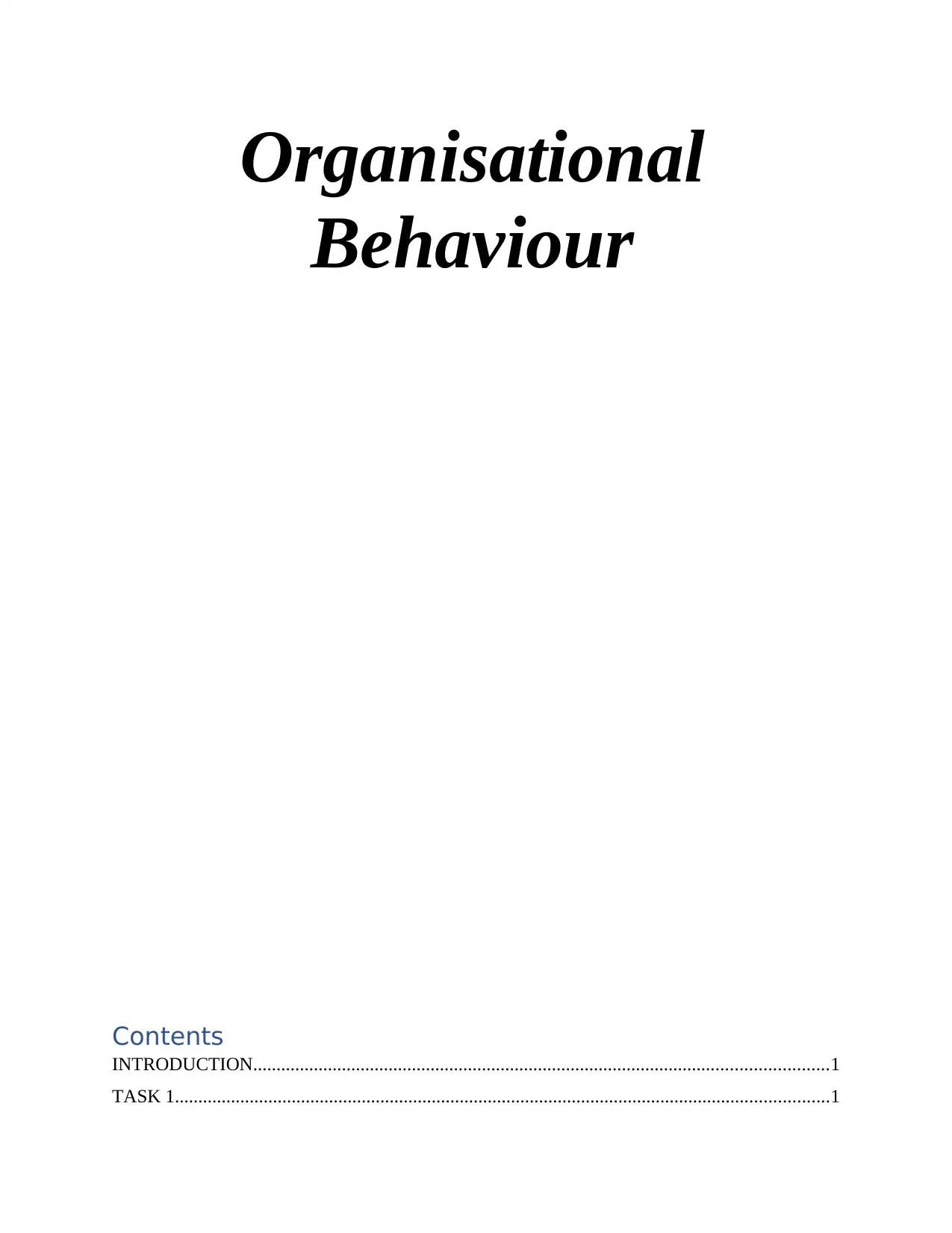
Organisational
Behaviour
Contents
INTRODUCTION...........................................................................................................................1
TASK 1............................................................................................................................................1
Behaviour
Contents
INTRODUCTION...........................................................................................................................1
TASK 1............................................................................................................................................1
Paraphrase This Document
Need a fresh take? Get an instant paraphrase of this document with our AI Paraphraser
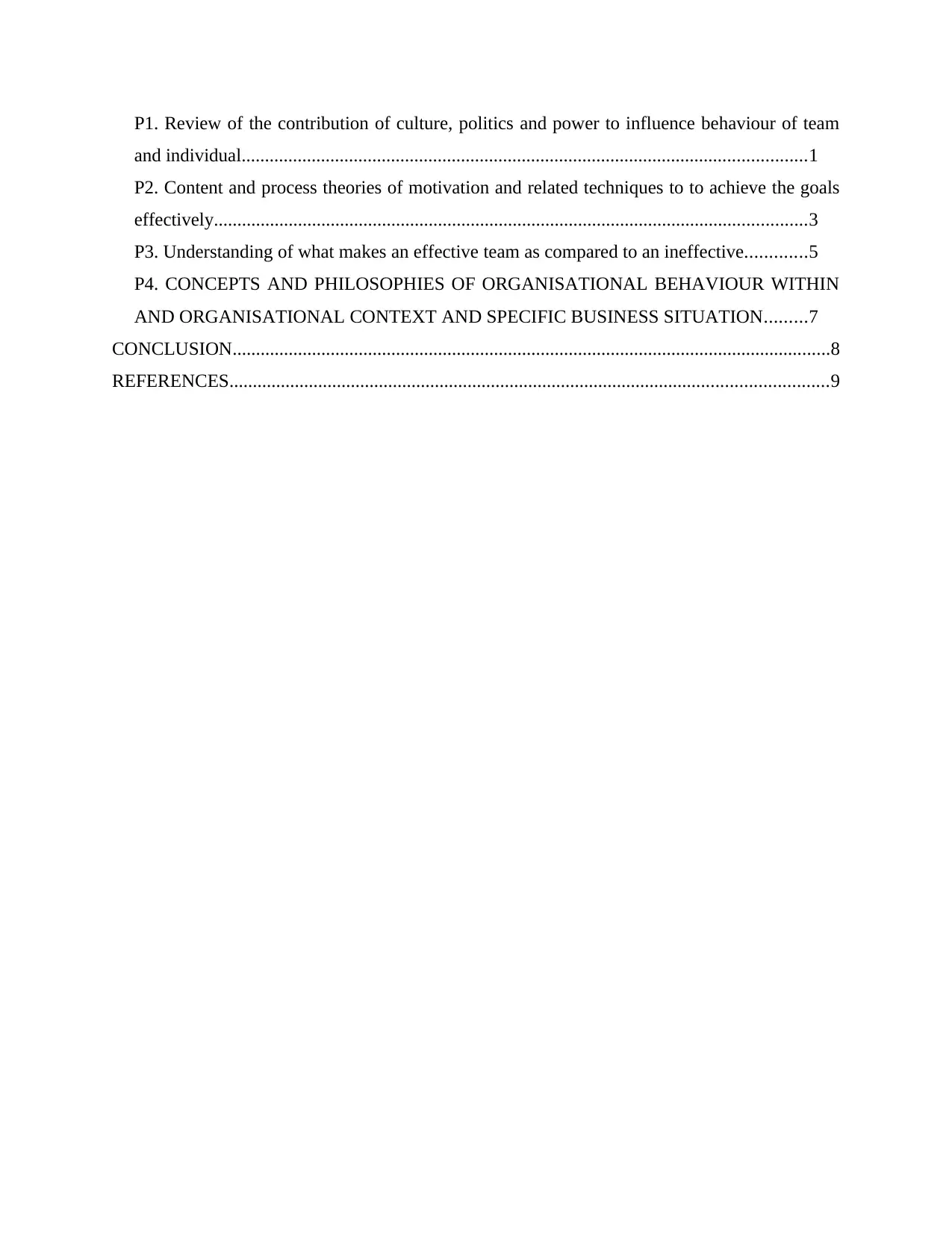
P1. Review of the contribution of culture, politics and power to influence behaviour of team
and individual.........................................................................................................................1
P2. Content and process theories of motivation and related techniques to to achieve the goals
effectively...............................................................................................................................3
P3. Understanding of what makes an effective team as compared to an ineffective.............5
P4. CONCEPTS AND PHILOSOPHIES OF ORGANISATIONAL BEHAVIOUR WITHIN
AND ORGANISATIONAL CONTEXT AND SPECIFIC BUSINESS SITUATION.........7
CONCLUSION................................................................................................................................8
REFERENCES................................................................................................................................9
and individual.........................................................................................................................1
P2. Content and process theories of motivation and related techniques to to achieve the goals
effectively...............................................................................................................................3
P3. Understanding of what makes an effective team as compared to an ineffective.............5
P4. CONCEPTS AND PHILOSOPHIES OF ORGANISATIONAL BEHAVIOUR WITHIN
AND ORGANISATIONAL CONTEXT AND SPECIFIC BUSINESS SITUATION.........7
CONCLUSION................................................................................................................................8
REFERENCES................................................................................................................................9

⊘ This is a preview!⊘
Do you want full access?
Subscribe today to unlock all pages.

Trusted by 1+ million students worldwide
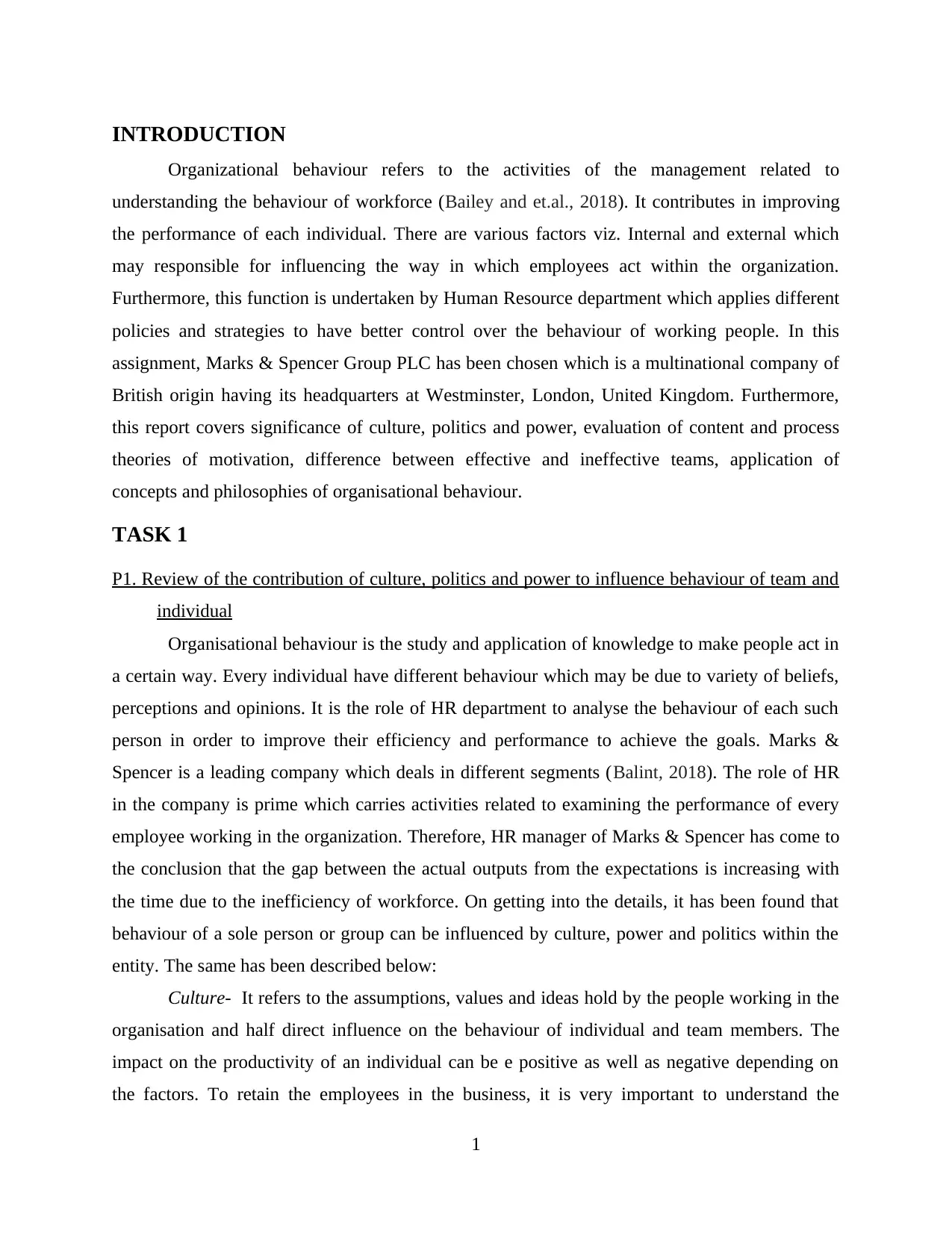
INTRODUCTION
Organizational behaviour refers to the activities of the management related to
understanding the behaviour of workforce (Bailey and et.al., 2018). It contributes in improving
the performance of each individual. There are various factors viz. Internal and external which
may responsible for influencing the way in which employees act within the organization.
Furthermore, this function is undertaken by Human Resource department which applies different
policies and strategies to have better control over the behaviour of working people. In this
assignment, Marks & Spencer Group PLC has been chosen which is a multinational company of
British origin having its headquarters at Westminster, London, United Kingdom. Furthermore,
this report covers significance of culture, politics and power, evaluation of content and process
theories of motivation, difference between effective and ineffective teams, application of
concepts and philosophies of organisational behaviour.
TASK 1
P1. Review of the contribution of culture, politics and power to influence behaviour of team and
individual
Organisational behaviour is the study and application of knowledge to make people act in
a certain way. Every individual have different behaviour which may be due to variety of beliefs,
perceptions and opinions. It is the role of HR department to analyse the behaviour of each such
person in order to improve their efficiency and performance to achieve the goals. Marks &
Spencer is a leading company which deals in different segments (Balint, 2018). The role of HR
in the company is prime which carries activities related to examining the performance of every
employee working in the organization. Therefore, HR manager of Marks & Spencer has come to
the conclusion that the gap between the actual outputs from the expectations is increasing with
the time due to the inefficiency of workforce. On getting into the details, it has been found that
behaviour of a sole person or group can be influenced by culture, power and politics within the
entity. The same has been described below:
Culture- It refers to the assumptions, values and ideas hold by the people working in the
organisation and half direct influence on the behaviour of individual and team members. The
impact on the productivity of an individual can be e positive as well as negative depending on
the factors. To retain the employees in the business, it is very important to understand the
1
Organizational behaviour refers to the activities of the management related to
understanding the behaviour of workforce (Bailey and et.al., 2018). It contributes in improving
the performance of each individual. There are various factors viz. Internal and external which
may responsible for influencing the way in which employees act within the organization.
Furthermore, this function is undertaken by Human Resource department which applies different
policies and strategies to have better control over the behaviour of working people. In this
assignment, Marks & Spencer Group PLC has been chosen which is a multinational company of
British origin having its headquarters at Westminster, London, United Kingdom. Furthermore,
this report covers significance of culture, politics and power, evaluation of content and process
theories of motivation, difference between effective and ineffective teams, application of
concepts and philosophies of organisational behaviour.
TASK 1
P1. Review of the contribution of culture, politics and power to influence behaviour of team and
individual
Organisational behaviour is the study and application of knowledge to make people act in
a certain way. Every individual have different behaviour which may be due to variety of beliefs,
perceptions and opinions. It is the role of HR department to analyse the behaviour of each such
person in order to improve their efficiency and performance to achieve the goals. Marks &
Spencer is a leading company which deals in different segments (Balint, 2018). The role of HR
in the company is prime which carries activities related to examining the performance of every
employee working in the organization. Therefore, HR manager of Marks & Spencer has come to
the conclusion that the gap between the actual outputs from the expectations is increasing with
the time due to the inefficiency of workforce. On getting into the details, it has been found that
behaviour of a sole person or group can be influenced by culture, power and politics within the
entity. The same has been described below:
Culture- It refers to the assumptions, values and ideas hold by the people working in the
organisation and half direct influence on the behaviour of individual and team members. The
impact on the productivity of an individual can be e positive as well as negative depending on
the factors. To retain the employees in the business, it is very important to understand the
1
Paraphrase This Document
Need a fresh take? Get an instant paraphrase of this document with our AI Paraphraser
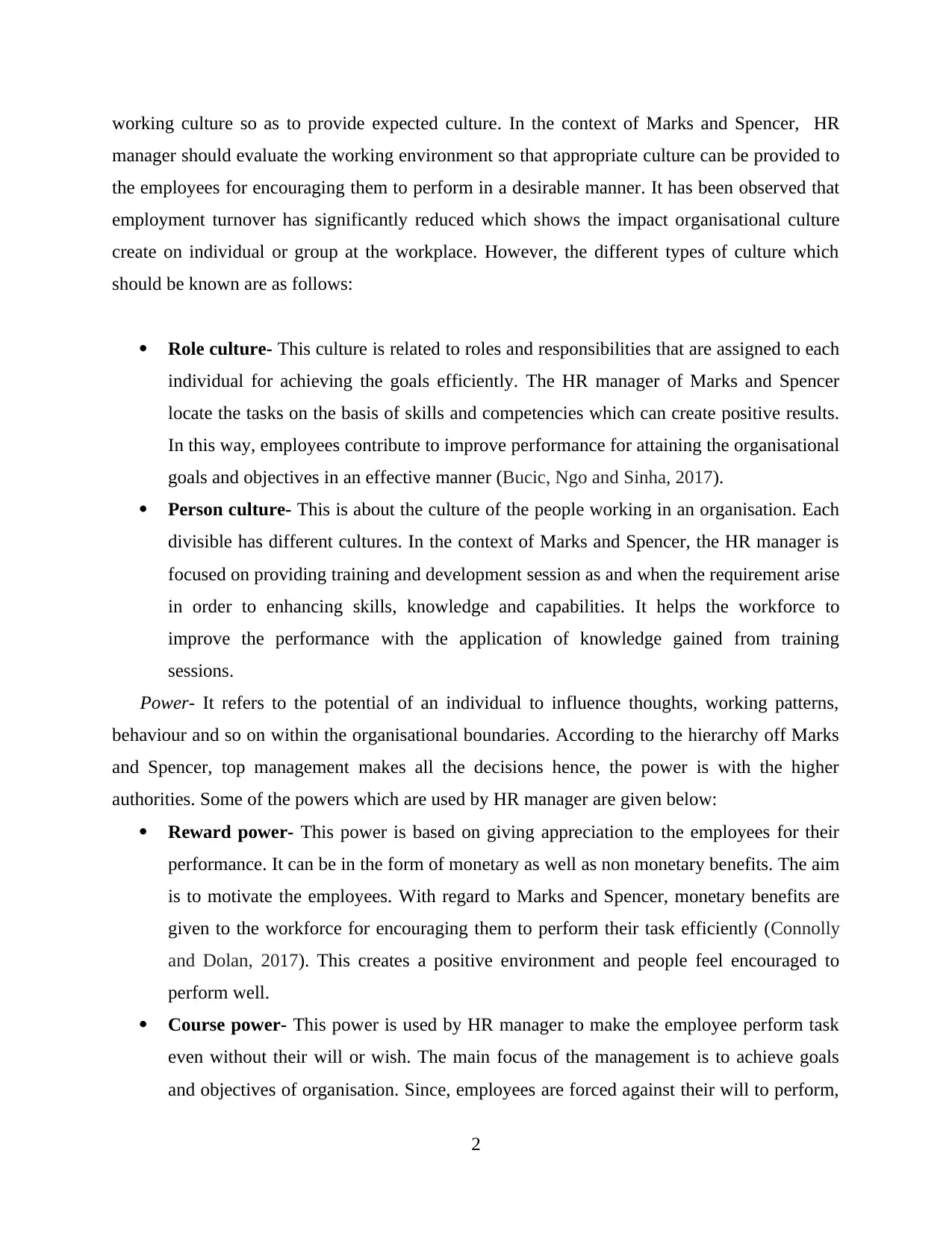
working culture so as to provide expected culture. In the context of Marks and Spencer, HR
manager should evaluate the working environment so that appropriate culture can be provided to
the employees for encouraging them to perform in a desirable manner. It has been observed that
employment turnover has significantly reduced which shows the impact organisational culture
create on individual or group at the workplace. However, the different types of culture which
should be known are as follows:
Role culture- This culture is related to roles and responsibilities that are assigned to each
individual for achieving the goals efficiently. The HR manager of Marks and Spencer
locate the tasks on the basis of skills and competencies which can create positive results.
In this way, employees contribute to improve performance for attaining the organisational
goals and objectives in an effective manner (Bucic, Ngo and Sinha, 2017).
Person culture- This is about the culture of the people working in an organisation. Each
divisible has different cultures. In the context of Marks and Spencer, the HR manager is
focused on providing training and development session as and when the requirement arise
in order to enhancing skills, knowledge and capabilities. It helps the workforce to
improve the performance with the application of knowledge gained from training
sessions.
Power- It refers to the potential of an individual to influence thoughts, working patterns,
behaviour and so on within the organisational boundaries. According to the hierarchy off Marks
and Spencer, top management makes all the decisions hence, the power is with the higher
authorities. Some of the powers which are used by HR manager are given below:
Reward power- This power is based on giving appreciation to the employees for their
performance. It can be in the form of monetary as well as non monetary benefits. The aim
is to motivate the employees. With regard to Marks and Spencer, monetary benefits are
given to the workforce for encouraging them to perform their task efficiently (Connolly
and Dolan, 2017). This creates a positive environment and people feel encouraged to
perform well.
Course power- This power is used by HR manager to make the employee perform task
even without their will or wish. The main focus of the management is to achieve goals
and objectives of organisation. Since, employees are forced against their will to perform,
2
manager should evaluate the working environment so that appropriate culture can be provided to
the employees for encouraging them to perform in a desirable manner. It has been observed that
employment turnover has significantly reduced which shows the impact organisational culture
create on individual or group at the workplace. However, the different types of culture which
should be known are as follows:
Role culture- This culture is related to roles and responsibilities that are assigned to each
individual for achieving the goals efficiently. The HR manager of Marks and Spencer
locate the tasks on the basis of skills and competencies which can create positive results.
In this way, employees contribute to improve performance for attaining the organisational
goals and objectives in an effective manner (Bucic, Ngo and Sinha, 2017).
Person culture- This is about the culture of the people working in an organisation. Each
divisible has different cultures. In the context of Marks and Spencer, the HR manager is
focused on providing training and development session as and when the requirement arise
in order to enhancing skills, knowledge and capabilities. It helps the workforce to
improve the performance with the application of knowledge gained from training
sessions.
Power- It refers to the potential of an individual to influence thoughts, working patterns,
behaviour and so on within the organisational boundaries. According to the hierarchy off Marks
and Spencer, top management makes all the decisions hence, the power is with the higher
authorities. Some of the powers which are used by HR manager are given below:
Reward power- This power is based on giving appreciation to the employees for their
performance. It can be in the form of monetary as well as non monetary benefits. The aim
is to motivate the employees. With regard to Marks and Spencer, monetary benefits are
given to the workforce for encouraging them to perform their task efficiently (Connolly
and Dolan, 2017). This creates a positive environment and people feel encouraged to
perform well.
Course power- This power is used by HR manager to make the employee perform task
even without their will or wish. The main focus of the management is to achieve goals
and objectives of organisation. Since, employees are forced against their will to perform,
2
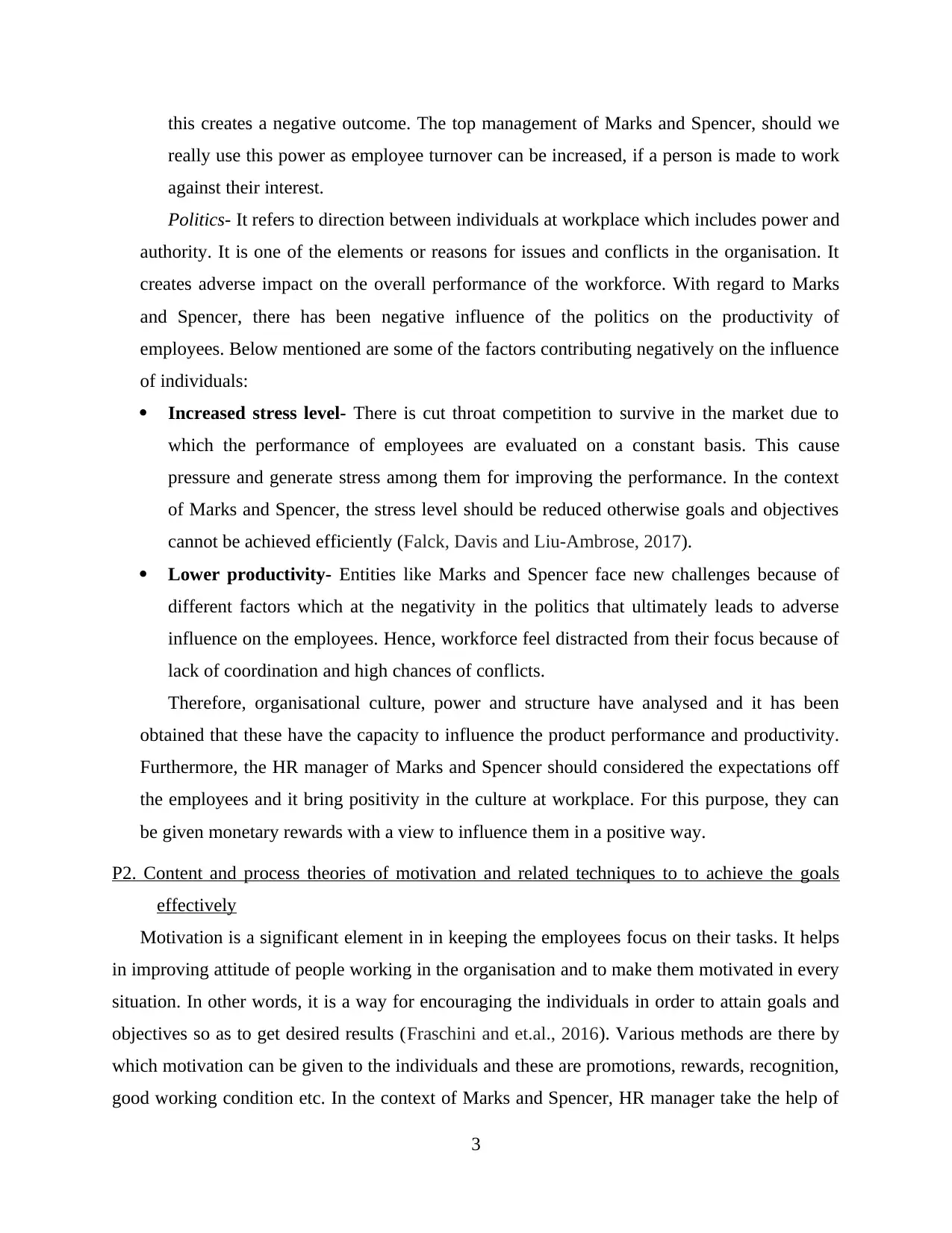
this creates a negative outcome. The top management of Marks and Spencer, should we
really use this power as employee turnover can be increased, if a person is made to work
against their interest.
Politics- It refers to direction between individuals at workplace which includes power and
authority. It is one of the elements or reasons for issues and conflicts in the organisation. It
creates adverse impact on the overall performance of the workforce. With regard to Marks
and Spencer, there has been negative influence of the politics on the productivity of
employees. Below mentioned are some of the factors contributing negatively on the influence
of individuals:
Increased stress level- There is cut throat competition to survive in the market due to
which the performance of employees are evaluated on a constant basis. This cause
pressure and generate stress among them for improving the performance. In the context
of Marks and Spencer, the stress level should be reduced otherwise goals and objectives
cannot be achieved efficiently (Falck, Davis and Liu-Ambrose, 2017).
Lower productivity- Entities like Marks and Spencer face new challenges because of
different factors which at the negativity in the politics that ultimately leads to adverse
influence on the employees. Hence, workforce feel distracted from their focus because of
lack of coordination and high chances of conflicts.
Therefore, organisational culture, power and structure have analysed and it has been
obtained that these have the capacity to influence the product performance and productivity.
Furthermore, the HR manager of Marks and Spencer should considered the expectations off
the employees and it bring positivity in the culture at workplace. For this purpose, they can
be given monetary rewards with a view to influence them in a positive way.
P2. Content and process theories of motivation and related techniques to to achieve the goals
effectively
Motivation is a significant element in in keeping the employees focus on their tasks. It helps
in improving attitude of people working in the organisation and to make them motivated in every
situation. In other words, it is a way for encouraging the individuals in order to attain goals and
objectives so as to get desired results (Fraschini and et.al., 2016). Various methods are there by
which motivation can be given to the individuals and these are promotions, rewards, recognition,
good working condition etc. In the context of Marks and Spencer, HR manager take the help of
3
really use this power as employee turnover can be increased, if a person is made to work
against their interest.
Politics- It refers to direction between individuals at workplace which includes power and
authority. It is one of the elements or reasons for issues and conflicts in the organisation. It
creates adverse impact on the overall performance of the workforce. With regard to Marks
and Spencer, there has been negative influence of the politics on the productivity of
employees. Below mentioned are some of the factors contributing negatively on the influence
of individuals:
Increased stress level- There is cut throat competition to survive in the market due to
which the performance of employees are evaluated on a constant basis. This cause
pressure and generate stress among them for improving the performance. In the context
of Marks and Spencer, the stress level should be reduced otherwise goals and objectives
cannot be achieved efficiently (Falck, Davis and Liu-Ambrose, 2017).
Lower productivity- Entities like Marks and Spencer face new challenges because of
different factors which at the negativity in the politics that ultimately leads to adverse
influence on the employees. Hence, workforce feel distracted from their focus because of
lack of coordination and high chances of conflicts.
Therefore, organisational culture, power and structure have analysed and it has been
obtained that these have the capacity to influence the product performance and productivity.
Furthermore, the HR manager of Marks and Spencer should considered the expectations off
the employees and it bring positivity in the culture at workplace. For this purpose, they can
be given monetary rewards with a view to influence them in a positive way.
P2. Content and process theories of motivation and related techniques to to achieve the goals
effectively
Motivation is a significant element in in keeping the employees focus on their tasks. It helps
in improving attitude of people working in the organisation and to make them motivated in every
situation. In other words, it is a way for encouraging the individuals in order to attain goals and
objectives so as to get desired results (Fraschini and et.al., 2016). Various methods are there by
which motivation can be given to the individuals and these are promotions, rewards, recognition,
good working condition etc. In the context of Marks and Spencer, HR manager take the help of
3
⊘ This is a preview!⊘
Do you want full access?
Subscribe today to unlock all pages.

Trusted by 1+ million students worldwide
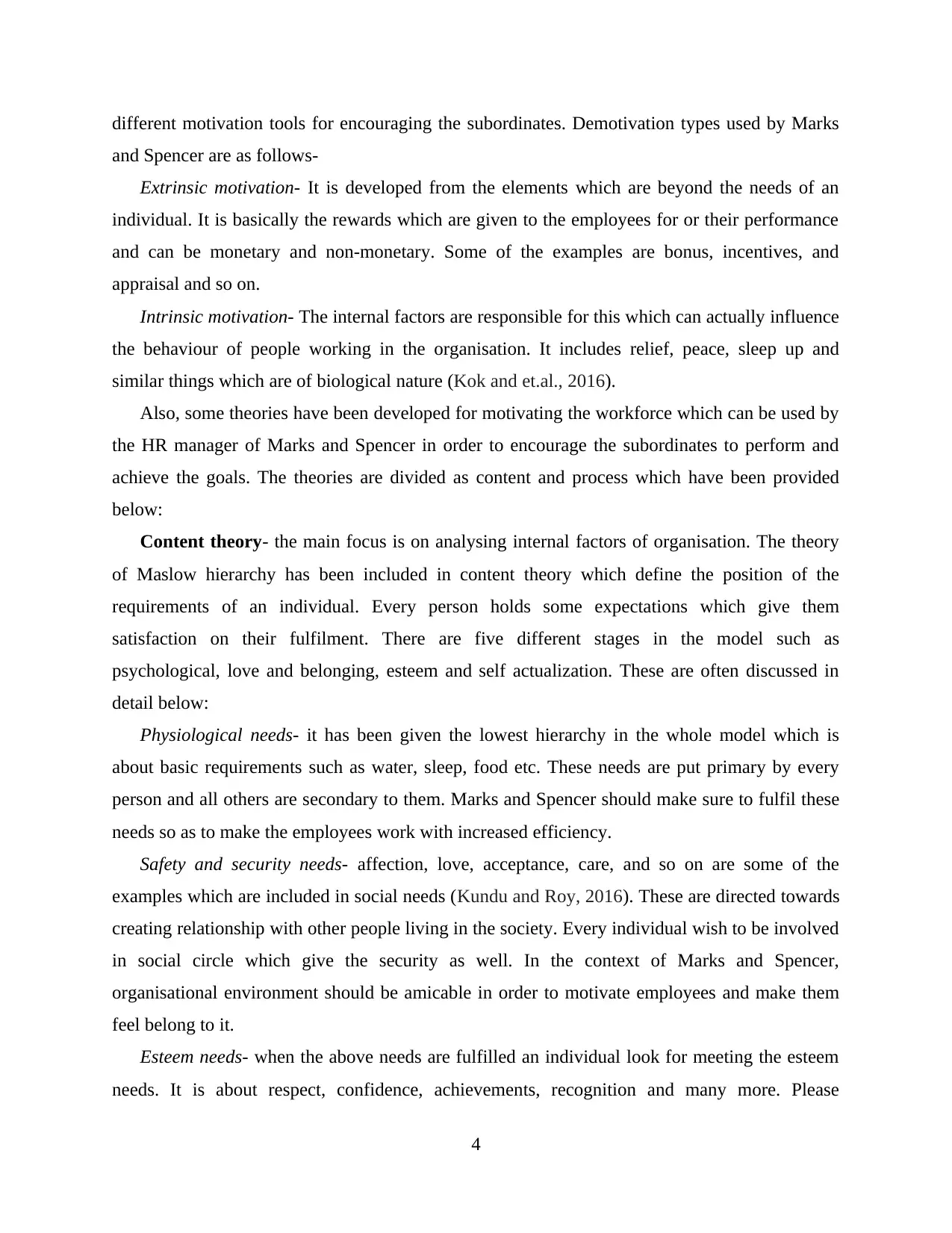
different motivation tools for encouraging the subordinates. Demotivation types used by Marks
and Spencer are as follows-
Extrinsic motivation- It is developed from the elements which are beyond the needs of an
individual. It is basically the rewards which are given to the employees for or their performance
and can be monetary and non-monetary. Some of the examples are bonus, incentives, and
appraisal and so on.
Intrinsic motivation- The internal factors are responsible for this which can actually influence
the behaviour of people working in the organisation. It includes relief, peace, sleep up and
similar things which are of biological nature (Kok and et.al., 2016).
Also, some theories have been developed for motivating the workforce which can be used by
the HR manager of Marks and Spencer in order to encourage the subordinates to perform and
achieve the goals. The theories are divided as content and process which have been provided
below:
Content theory- the main focus is on analysing internal factors of organisation. The theory
of Maslow hierarchy has been included in content theory which define the position of the
requirements of an individual. Every person holds some expectations which give them
satisfaction on their fulfilment. There are five different stages in the model such as
psychological, love and belonging, esteem and self actualization. These are often discussed in
detail below:
Physiological needs- it has been given the lowest hierarchy in the whole model which is
about basic requirements such as water, sleep, food etc. These needs are put primary by every
person and all others are secondary to them. Marks and Spencer should make sure to fulfil these
needs so as to make the employees work with increased efficiency.
Safety and security needs- affection, love, acceptance, care, and so on are some of the
examples which are included in social needs (Kundu and Roy, 2016). These are directed towards
creating relationship with other people living in the society. Every individual wish to be involved
in social circle which give the security as well. In the context of Marks and Spencer,
organisational environment should be amicable in order to motivate employees and make them
feel belong to it.
Esteem needs- when the above needs are fulfilled an individual look for meeting the esteem
needs. It is about respect, confidence, achievements, recognition and many more. Please
4
and Spencer are as follows-
Extrinsic motivation- It is developed from the elements which are beyond the needs of an
individual. It is basically the rewards which are given to the employees for or their performance
and can be monetary and non-monetary. Some of the examples are bonus, incentives, and
appraisal and so on.
Intrinsic motivation- The internal factors are responsible for this which can actually influence
the behaviour of people working in the organisation. It includes relief, peace, sleep up and
similar things which are of biological nature (Kok and et.al., 2016).
Also, some theories have been developed for motivating the workforce which can be used by
the HR manager of Marks and Spencer in order to encourage the subordinates to perform and
achieve the goals. The theories are divided as content and process which have been provided
below:
Content theory- the main focus is on analysing internal factors of organisation. The theory
of Maslow hierarchy has been included in content theory which define the position of the
requirements of an individual. Every person holds some expectations which give them
satisfaction on their fulfilment. There are five different stages in the model such as
psychological, love and belonging, esteem and self actualization. These are often discussed in
detail below:
Physiological needs- it has been given the lowest hierarchy in the whole model which is
about basic requirements such as water, sleep, food etc. These needs are put primary by every
person and all others are secondary to them. Marks and Spencer should make sure to fulfil these
needs so as to make the employees work with increased efficiency.
Safety and security needs- affection, love, acceptance, care, and so on are some of the
examples which are included in social needs (Kundu and Roy, 2016). These are directed towards
creating relationship with other people living in the society. Every individual wish to be involved
in social circle which give the security as well. In the context of Marks and Spencer,
organisational environment should be amicable in order to motivate employees and make them
feel belong to it.
Esteem needs- when the above needs are fulfilled an individual look for meeting the esteem
needs. It is about respect, confidence, achievements, recognition and many more. Please
4
Paraphrase This Document
Need a fresh take? Get an instant paraphrase of this document with our AI Paraphraser
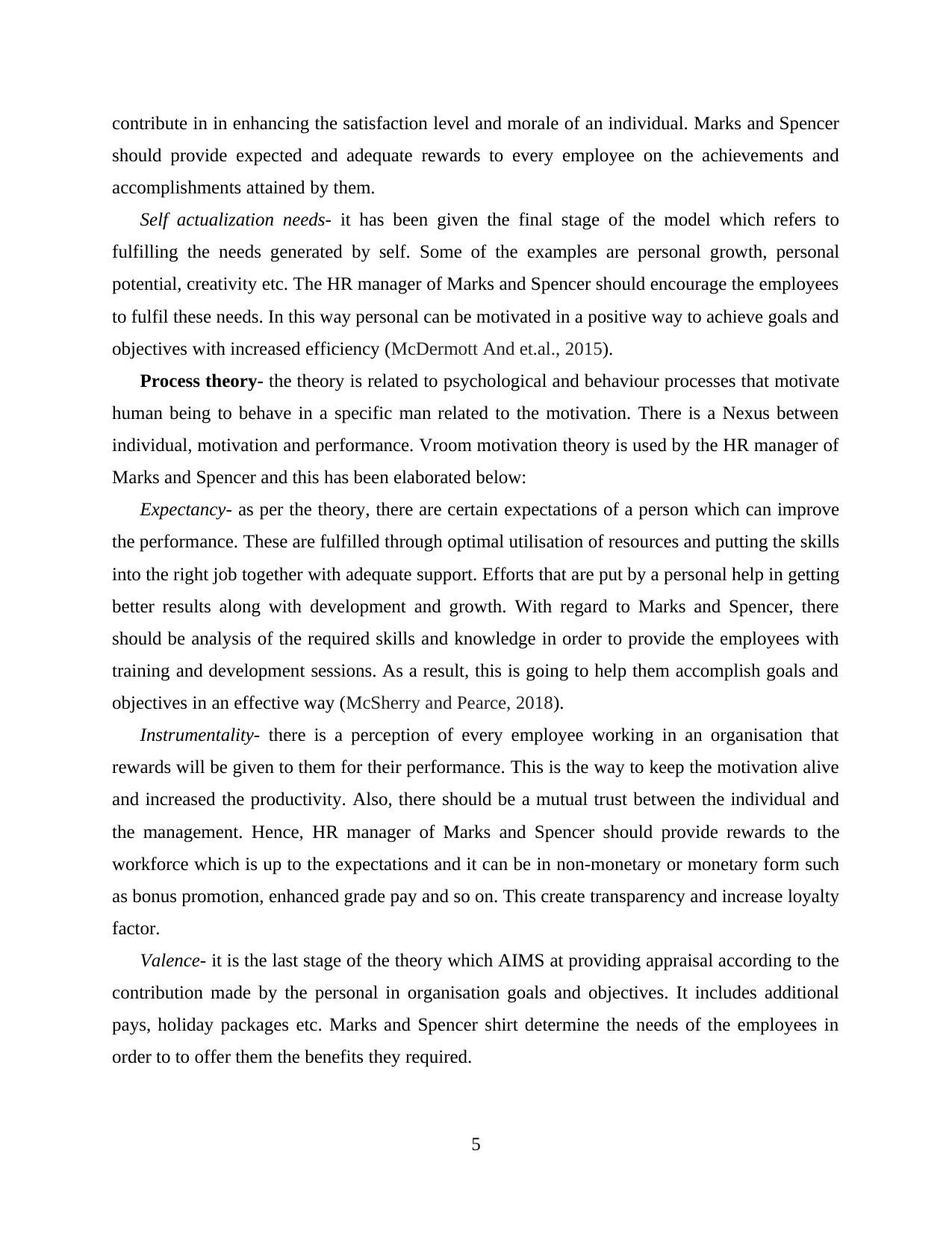
contribute in in enhancing the satisfaction level and morale of an individual. Marks and Spencer
should provide expected and adequate rewards to every employee on the achievements and
accomplishments attained by them.
Self actualization needs- it has been given the final stage of the model which refers to
fulfilling the needs generated by self. Some of the examples are personal growth, personal
potential, creativity etc. The HR manager of Marks and Spencer should encourage the employees
to fulfil these needs. In this way personal can be motivated in a positive way to achieve goals and
objectives with increased efficiency (McDermott And et.al., 2015).
Process theory- the theory is related to psychological and behaviour processes that motivate
human being to behave in a specific man related to the motivation. There is a Nexus between
individual, motivation and performance. Vroom motivation theory is used by the HR manager of
Marks and Spencer and this has been elaborated below:
Expectancy- as per the theory, there are certain expectations of a person which can improve
the performance. These are fulfilled through optimal utilisation of resources and putting the skills
into the right job together with adequate support. Efforts that are put by a personal help in getting
better results along with development and growth. With regard to Marks and Spencer, there
should be analysis of the required skills and knowledge in order to provide the employees with
training and development sessions. As a result, this is going to help them accomplish goals and
objectives in an effective way (McSherry and Pearce, 2018).
Instrumentality- there is a perception of every employee working in an organisation that
rewards will be given to them for their performance. This is the way to keep the motivation alive
and increased the productivity. Also, there should be a mutual trust between the individual and
the management. Hence, HR manager of Marks and Spencer should provide rewards to the
workforce which is up to the expectations and it can be in non-monetary or monetary form such
as bonus promotion, enhanced grade pay and so on. This create transparency and increase loyalty
factor.
Valence- it is the last stage of the theory which AIMS at providing appraisal according to the
contribution made by the personal in organisation goals and objectives. It includes additional
pays, holiday packages etc. Marks and Spencer shirt determine the needs of the employees in
order to to offer them the benefits they required.
5
should provide expected and adequate rewards to every employee on the achievements and
accomplishments attained by them.
Self actualization needs- it has been given the final stage of the model which refers to
fulfilling the needs generated by self. Some of the examples are personal growth, personal
potential, creativity etc. The HR manager of Marks and Spencer should encourage the employees
to fulfil these needs. In this way personal can be motivated in a positive way to achieve goals and
objectives with increased efficiency (McDermott And et.al., 2015).
Process theory- the theory is related to psychological and behaviour processes that motivate
human being to behave in a specific man related to the motivation. There is a Nexus between
individual, motivation and performance. Vroom motivation theory is used by the HR manager of
Marks and Spencer and this has been elaborated below:
Expectancy- as per the theory, there are certain expectations of a person which can improve
the performance. These are fulfilled through optimal utilisation of resources and putting the skills
into the right job together with adequate support. Efforts that are put by a personal help in getting
better results along with development and growth. With regard to Marks and Spencer, there
should be analysis of the required skills and knowledge in order to provide the employees with
training and development sessions. As a result, this is going to help them accomplish goals and
objectives in an effective way (McSherry and Pearce, 2018).
Instrumentality- there is a perception of every employee working in an organisation that
rewards will be given to them for their performance. This is the way to keep the motivation alive
and increased the productivity. Also, there should be a mutual trust between the individual and
the management. Hence, HR manager of Marks and Spencer should provide rewards to the
workforce which is up to the expectations and it can be in non-monetary or monetary form such
as bonus promotion, enhanced grade pay and so on. This create transparency and increase loyalty
factor.
Valence- it is the last stage of the theory which AIMS at providing appraisal according to the
contribution made by the personal in organisation goals and objectives. It includes additional
pays, holiday packages etc. Marks and Spencer shirt determine the needs of the employees in
order to to offer them the benefits they required.
5
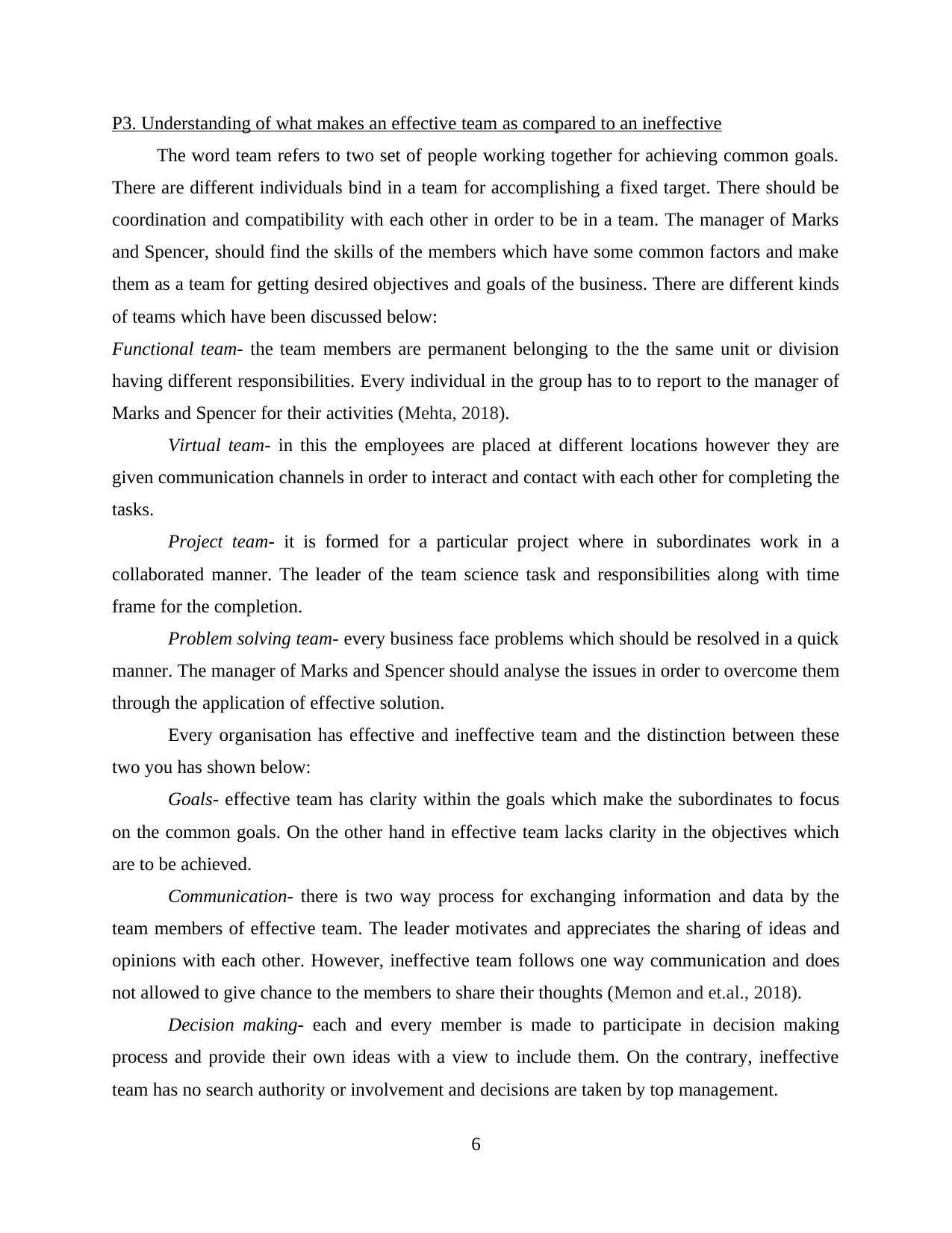
P3. Understanding of what makes an effective team as compared to an ineffective
The word team refers to two set of people working together for achieving common goals.
There are different individuals bind in a team for accomplishing a fixed target. There should be
coordination and compatibility with each other in order to be in a team. The manager of Marks
and Spencer, should find the skills of the members which have some common factors and make
them as a team for getting desired objectives and goals of the business. There are different kinds
of teams which have been discussed below:
Functional team- the team members are permanent belonging to the the same unit or division
having different responsibilities. Every individual in the group has to to report to the manager of
Marks and Spencer for their activities (Mehta, 2018).
Virtual team- in this the employees are placed at different locations however they are
given communication channels in order to interact and contact with each other for completing the
tasks.
Project team- it is formed for a particular project where in subordinates work in a
collaborated manner. The leader of the team science task and responsibilities along with time
frame for the completion.
Problem solving team- every business face problems which should be resolved in a quick
manner. The manager of Marks and Spencer should analyse the issues in order to overcome them
through the application of effective solution.
Every organisation has effective and ineffective team and the distinction between these
two you has shown below:
Goals- effective team has clarity within the goals which make the subordinates to focus
on the common goals. On the other hand in effective team lacks clarity in the objectives which
are to be achieved.
Communication- there is two way process for exchanging information and data by the
team members of effective team. The leader motivates and appreciates the sharing of ideas and
opinions with each other. However, ineffective team follows one way communication and does
not allowed to give chance to the members to share their thoughts (Memon and et.al., 2018).
Decision making- each and every member is made to participate in decision making
process and provide their own ideas with a view to include them. On the contrary, ineffective
team has no search authority or involvement and decisions are taken by top management.
6
The word team refers to two set of people working together for achieving common goals.
There are different individuals bind in a team for accomplishing a fixed target. There should be
coordination and compatibility with each other in order to be in a team. The manager of Marks
and Spencer, should find the skills of the members which have some common factors and make
them as a team for getting desired objectives and goals of the business. There are different kinds
of teams which have been discussed below:
Functional team- the team members are permanent belonging to the the same unit or division
having different responsibilities. Every individual in the group has to to report to the manager of
Marks and Spencer for their activities (Mehta, 2018).
Virtual team- in this the employees are placed at different locations however they are
given communication channels in order to interact and contact with each other for completing the
tasks.
Project team- it is formed for a particular project where in subordinates work in a
collaborated manner. The leader of the team science task and responsibilities along with time
frame for the completion.
Problem solving team- every business face problems which should be resolved in a quick
manner. The manager of Marks and Spencer should analyse the issues in order to overcome them
through the application of effective solution.
Every organisation has effective and ineffective team and the distinction between these
two you has shown below:
Goals- effective team has clarity within the goals which make the subordinates to focus
on the common goals. On the other hand in effective team lacks clarity in the objectives which
are to be achieved.
Communication- there is two way process for exchanging information and data by the
team members of effective team. The leader motivates and appreciates the sharing of ideas and
opinions with each other. However, ineffective team follows one way communication and does
not allowed to give chance to the members to share their thoughts (Memon and et.al., 2018).
Decision making- each and every member is made to participate in decision making
process and provide their own ideas with a view to include them. On the contrary, ineffective
team has no search authority or involvement and decisions are taken by top management.
6
⊘ This is a preview!⊘
Do you want full access?
Subscribe today to unlock all pages.

Trusted by 1+ million students worldwide
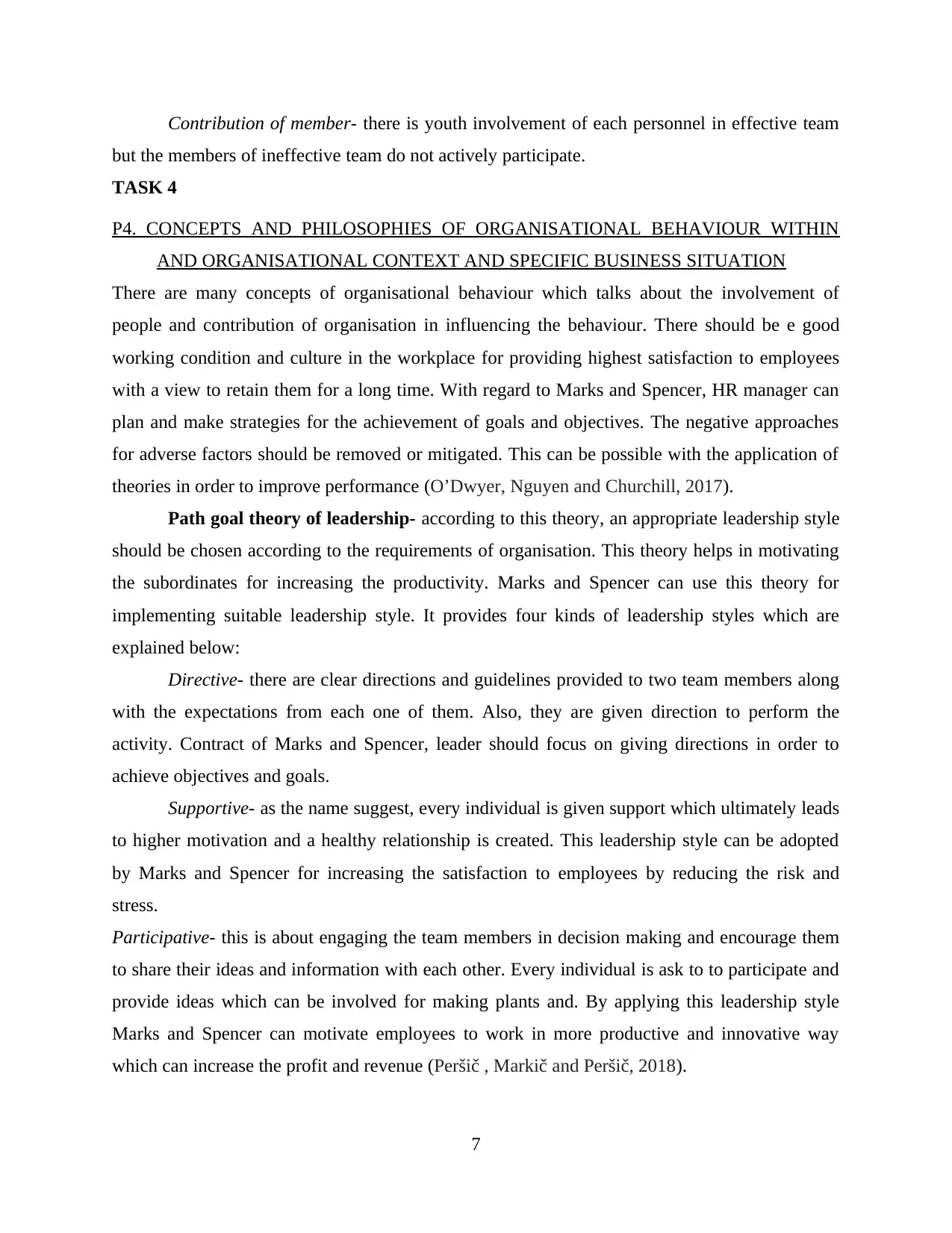
Contribution of member- there is youth involvement of each personnel in effective team
but the members of ineffective team do not actively participate.
TASK 4
P4. CONCEPTS AND PHILOSOPHIES OF ORGANISATIONAL BEHAVIOUR WITHIN
AND ORGANISATIONAL CONTEXT AND SPECIFIC BUSINESS SITUATION
There are many concepts of organisational behaviour which talks about the involvement of
people and contribution of organisation in influencing the behaviour. There should be e good
working condition and culture in the workplace for providing highest satisfaction to employees
with a view to retain them for a long time. With regard to Marks and Spencer, HR manager can
plan and make strategies for the achievement of goals and objectives. The negative approaches
for adverse factors should be removed or mitigated. This can be possible with the application of
theories in order to improve performance (O’Dwyer, Nguyen and Churchill, 2017).
Path goal theory of leadership- according to this theory, an appropriate leadership style
should be chosen according to the requirements of organisation. This theory helps in motivating
the subordinates for increasing the productivity. Marks and Spencer can use this theory for
implementing suitable leadership style. It provides four kinds of leadership styles which are
explained below:
Directive- there are clear directions and guidelines provided to two team members along
with the expectations from each one of them. Also, they are given direction to perform the
activity. Contract of Marks and Spencer, leader should focus on giving directions in order to
achieve objectives and goals.
Supportive- as the name suggest, every individual is given support which ultimately leads
to higher motivation and a healthy relationship is created. This leadership style can be adopted
by Marks and Spencer for increasing the satisfaction to employees by reducing the risk and
stress.
Participative- this is about engaging the team members in decision making and encourage them
to share their ideas and information with each other. Every individual is ask to to participate and
provide ideas which can be involved for making plants and. By applying this leadership style
Marks and Spencer can motivate employees to work in more productive and innovative way
which can increase the profit and revenue (Peršič , Markič and Peršič, 2018).
7
but the members of ineffective team do not actively participate.
TASK 4
P4. CONCEPTS AND PHILOSOPHIES OF ORGANISATIONAL BEHAVIOUR WITHIN
AND ORGANISATIONAL CONTEXT AND SPECIFIC BUSINESS SITUATION
There are many concepts of organisational behaviour which talks about the involvement of
people and contribution of organisation in influencing the behaviour. There should be e good
working condition and culture in the workplace for providing highest satisfaction to employees
with a view to retain them for a long time. With regard to Marks and Spencer, HR manager can
plan and make strategies for the achievement of goals and objectives. The negative approaches
for adverse factors should be removed or mitigated. This can be possible with the application of
theories in order to improve performance (O’Dwyer, Nguyen and Churchill, 2017).
Path goal theory of leadership- according to this theory, an appropriate leadership style
should be chosen according to the requirements of organisation. This theory helps in motivating
the subordinates for increasing the productivity. Marks and Spencer can use this theory for
implementing suitable leadership style. It provides four kinds of leadership styles which are
explained below:
Directive- there are clear directions and guidelines provided to two team members along
with the expectations from each one of them. Also, they are given direction to perform the
activity. Contract of Marks and Spencer, leader should focus on giving directions in order to
achieve objectives and goals.
Supportive- as the name suggest, every individual is given support which ultimately leads
to higher motivation and a healthy relationship is created. This leadership style can be adopted
by Marks and Spencer for increasing the satisfaction to employees by reducing the risk and
stress.
Participative- this is about engaging the team members in decision making and encourage them
to share their ideas and information with each other. Every individual is ask to to participate and
provide ideas which can be involved for making plants and. By applying this leadership style
Marks and Spencer can motivate employees to work in more productive and innovative way
which can increase the profit and revenue (Peršič , Markič and Peršič, 2018).
7
Paraphrase This Document
Need a fresh take? Get an instant paraphrase of this document with our AI Paraphraser
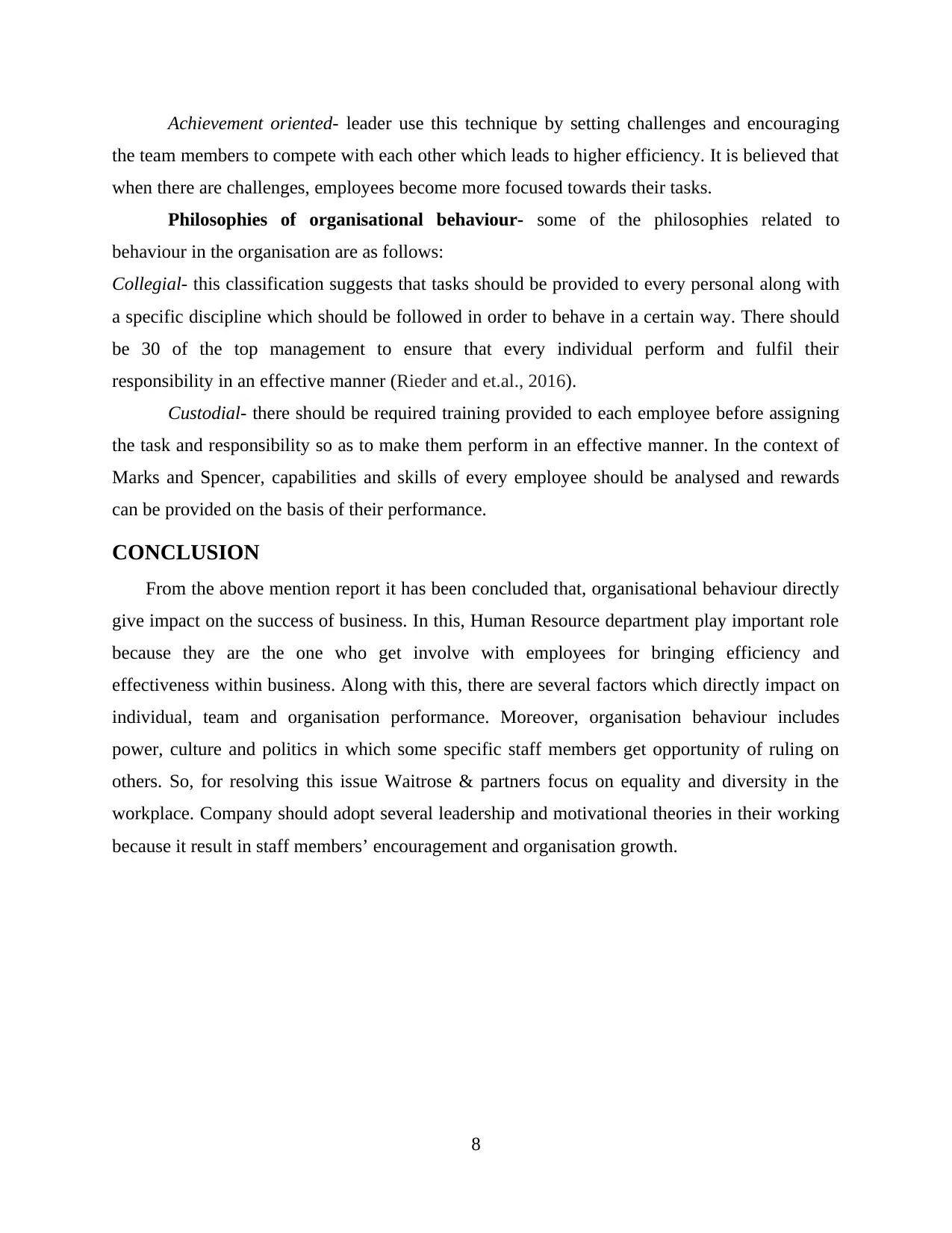
Achievement oriented- leader use this technique by setting challenges and encouraging
the team members to compete with each other which leads to higher efficiency. It is believed that
when there are challenges, employees become more focused towards their tasks.
Philosophies of organisational behaviour- some of the philosophies related to
behaviour in the organisation are as follows:
Collegial- this classification suggests that tasks should be provided to every personal along with
a specific discipline which should be followed in order to behave in a certain way. There should
be 30 of the top management to ensure that every individual perform and fulfil their
responsibility in an effective manner (Rieder and et.al., 2016).
Custodial- there should be required training provided to each employee before assigning
the task and responsibility so as to make them perform in an effective manner. In the context of
Marks and Spencer, capabilities and skills of every employee should be analysed and rewards
can be provided on the basis of their performance.
CONCLUSION
From the above mention report it has been concluded that, organisational behaviour directly
give impact on the success of business. In this, Human Resource department play important role
because they are the one who get involve with employees for bringing efficiency and
effectiveness within business. Along with this, there are several factors which directly impact on
individual, team and organisation performance. Moreover, organisation behaviour includes
power, culture and politics in which some specific staff members get opportunity of ruling on
others. So, for resolving this issue Waitrose & partners focus on equality and diversity in the
workplace. Company should adopt several leadership and motivational theories in their working
because it result in staff members’ encouragement and organisation growth.
8
the team members to compete with each other which leads to higher efficiency. It is believed that
when there are challenges, employees become more focused towards their tasks.
Philosophies of organisational behaviour- some of the philosophies related to
behaviour in the organisation are as follows:
Collegial- this classification suggests that tasks should be provided to every personal along with
a specific discipline which should be followed in order to behave in a certain way. There should
be 30 of the top management to ensure that every individual perform and fulfil their
responsibility in an effective manner (Rieder and et.al., 2016).
Custodial- there should be required training provided to each employee before assigning
the task and responsibility so as to make them perform in an effective manner. In the context of
Marks and Spencer, capabilities and skills of every employee should be analysed and rewards
can be provided on the basis of their performance.
CONCLUSION
From the above mention report it has been concluded that, organisational behaviour directly
give impact on the success of business. In this, Human Resource department play important role
because they are the one who get involve with employees for bringing efficiency and
effectiveness within business. Along with this, there are several factors which directly impact on
individual, team and organisation performance. Moreover, organisation behaviour includes
power, culture and politics in which some specific staff members get opportunity of ruling on
others. So, for resolving this issue Waitrose & partners focus on equality and diversity in the
workplace. Company should adopt several leadership and motivational theories in their working
because it result in staff members’ encouragement and organisation growth.
8
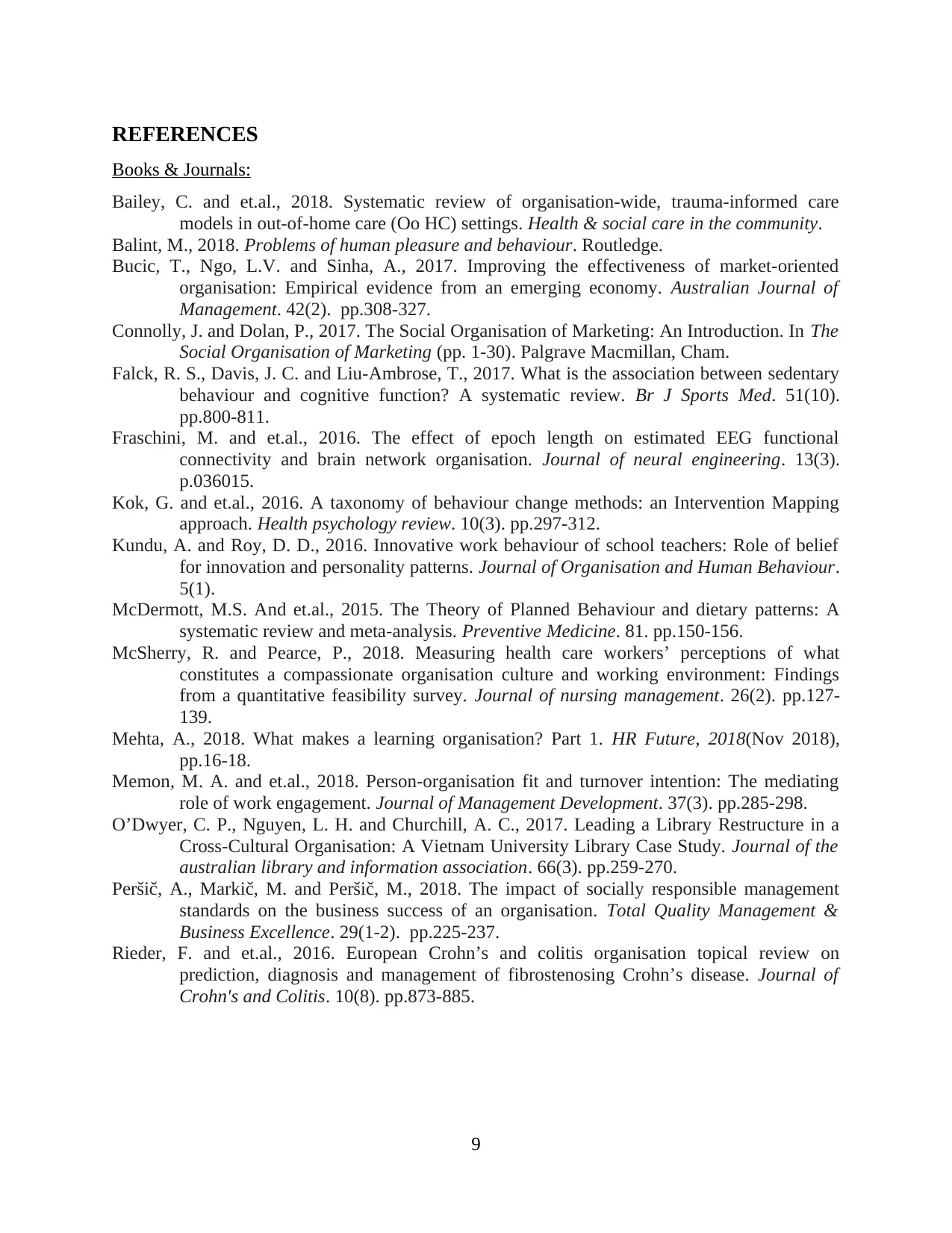
REFERENCES
Books & Journals:
Bailey, C. and et.al., 2018. Systematic review of organisation‐wide, trauma‐informed care
models in out‐of‐home care (Oo HC) settings. Health & social care in the community.
Balint, M., 2018. Problems of human pleasure and behaviour. Routledge.
Bucic, T., Ngo, L.V. and Sinha, A., 2017. Improving the effectiveness of market-oriented
organisation: Empirical evidence from an emerging economy. Australian Journal of
Management. 42(2). pp.308-327.
Connolly, J. and Dolan, P., 2017. The Social Organisation of Marketing: An Introduction. In The
Social Organisation of Marketing (pp. 1-30). Palgrave Macmillan, Cham.
Falck, R. S., Davis, J. C. and Liu-Ambrose, T., 2017. What is the association between sedentary
behaviour and cognitive function? A systematic review. Br J Sports Med. 51(10).
pp.800-811.
Fraschini, M. and et.al., 2016. The effect of epoch length on estimated EEG functional
connectivity and brain network organisation. Journal of neural engineering. 13(3).
p.036015.
Kok, G. and et.al., 2016. A taxonomy of behaviour change methods: an Intervention Mapping
approach. Health psychology review. 10(3). pp.297-312.
Kundu, A. and Roy, D. D., 2016. Innovative work behaviour of school teachers: Role of belief
for innovation and personality patterns. Journal of Organisation and Human Behaviour.
5(1).
McDermott, M.S. And et.al., 2015. The Theory of Planned Behaviour and dietary patterns: A
systematic review and meta-analysis. Preventive Medicine. 81. pp.150-156.
McSherry, R. and Pearce, P., 2018. Measuring health care workers’ perceptions of what
constitutes a compassionate organisation culture and working environment: Findings
from a quantitative feasibility survey. Journal of nursing management. 26(2). pp.127-
139.
Mehta, A., 2018. What makes a learning organisation? Part 1. HR Future, 2018(Nov 2018),
pp.16-18.
Memon, M. A. and et.al., 2018. Person-organisation fit and turnover intention: The mediating
role of work engagement. Journal of Management Development. 37(3). pp.285-298.
O’Dwyer, C. P., Nguyen, L. H. and Churchill, A. C., 2017. Leading a Library Restructure in a
Cross-Cultural Organisation: A Vietnam University Library Case Study. Journal of the
australian library and information association. 66(3). pp.259-270.
Peršič, A., Markič, M. and Peršič, M., 2018. The impact of socially responsible management
standards on the business success of an organisation. Total Quality Management &
Business Excellence. 29(1-2). pp.225-237.
Rieder, F. and et.al., 2016. European Crohn’s and colitis organisation topical review on
prediction, diagnosis and management of fibrostenosing Crohn’s disease. Journal of
Crohn's and Colitis. 10(8). pp.873-885.
9
Books & Journals:
Bailey, C. and et.al., 2018. Systematic review of organisation‐wide, trauma‐informed care
models in out‐of‐home care (Oo HC) settings. Health & social care in the community.
Balint, M., 2018. Problems of human pleasure and behaviour. Routledge.
Bucic, T., Ngo, L.V. and Sinha, A., 2017. Improving the effectiveness of market-oriented
organisation: Empirical evidence from an emerging economy. Australian Journal of
Management. 42(2). pp.308-327.
Connolly, J. and Dolan, P., 2017. The Social Organisation of Marketing: An Introduction. In The
Social Organisation of Marketing (pp. 1-30). Palgrave Macmillan, Cham.
Falck, R. S., Davis, J. C. and Liu-Ambrose, T., 2017. What is the association between sedentary
behaviour and cognitive function? A systematic review. Br J Sports Med. 51(10).
pp.800-811.
Fraschini, M. and et.al., 2016. The effect of epoch length on estimated EEG functional
connectivity and brain network organisation. Journal of neural engineering. 13(3).
p.036015.
Kok, G. and et.al., 2016. A taxonomy of behaviour change methods: an Intervention Mapping
approach. Health psychology review. 10(3). pp.297-312.
Kundu, A. and Roy, D. D., 2016. Innovative work behaviour of school teachers: Role of belief
for innovation and personality patterns. Journal of Organisation and Human Behaviour.
5(1).
McDermott, M.S. And et.al., 2015. The Theory of Planned Behaviour and dietary patterns: A
systematic review and meta-analysis. Preventive Medicine. 81. pp.150-156.
McSherry, R. and Pearce, P., 2018. Measuring health care workers’ perceptions of what
constitutes a compassionate organisation culture and working environment: Findings
from a quantitative feasibility survey. Journal of nursing management. 26(2). pp.127-
139.
Mehta, A., 2018. What makes a learning organisation? Part 1. HR Future, 2018(Nov 2018),
pp.16-18.
Memon, M. A. and et.al., 2018. Person-organisation fit and turnover intention: The mediating
role of work engagement. Journal of Management Development. 37(3). pp.285-298.
O’Dwyer, C. P., Nguyen, L. H. and Churchill, A. C., 2017. Leading a Library Restructure in a
Cross-Cultural Organisation: A Vietnam University Library Case Study. Journal of the
australian library and information association. 66(3). pp.259-270.
Peršič, A., Markič, M. and Peršič, M., 2018. The impact of socially responsible management
standards on the business success of an organisation. Total Quality Management &
Business Excellence. 29(1-2). pp.225-237.
Rieder, F. and et.al., 2016. European Crohn’s and colitis organisation topical review on
prediction, diagnosis and management of fibrostenosing Crohn’s disease. Journal of
Crohn's and Colitis. 10(8). pp.873-885.
9
⊘ This is a preview!⊘
Do you want full access?
Subscribe today to unlock all pages.

Trusted by 1+ million students worldwide
1 out of 14
Related Documents
Your All-in-One AI-Powered Toolkit for Academic Success.
+13062052269
info@desklib.com
Available 24*7 on WhatsApp / Email
![[object Object]](/_next/static/media/star-bottom.7253800d.svg)
Unlock your academic potential
Copyright © 2020–2025 A2Z Services. All Rights Reserved. Developed and managed by ZUCOL.



